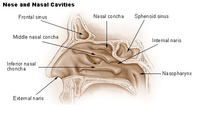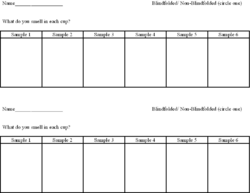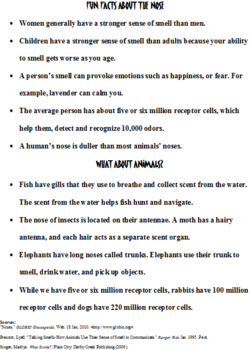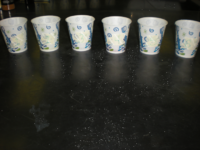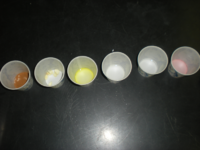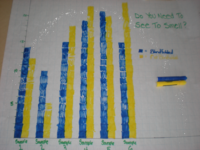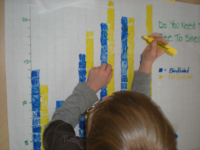Whose nose knows
| Students @ Work - a student collaborative writing project. Help us by providing feedback on the Discussion page. |
| Instant wiki maker | Making handouts | Editing tips |
Biology In Elementary Schools is a Saint Michael's College student project from a course that ran between 2007 and 2010 and fully described in this book chapter. The student-created resources have been preserved here for posterity. Link under 'toolbox' for printer-friendly versions of the exercises. Click on handouts to print full resolution versions. Please see Wikieducator's disclaimer, our safety statement, and the Creative Commons licensing in English and in legalese.
Student worthiness
This activity has been used with several groups of 2nd grade students.
Primary biological content area covered
This activity provides students with the opportunity to explore their sense of smell. Students will determine whether sight affects their sense of smell and build a graph of their scientific findings.
Materials
Materials for Teacher's Use
- Discussion materials/data
- Data Results graph (empty)
Materials for Student Groups
- 5 blindfolds
- 10 small cups
- Peppermint extract
- Lemon extract
- Coffee grounds (1 oz.)
- Fresh strawberry
- Garlic (1 oz.)
- Graph paper
Materials for Individual Students
- Recording Data handout
- Pencils
- Blue and yellow markers
Handouts
A handout that will be provided to each student will be a source that provides some interesting information about noses. This handout will incorporate some basic information about the human nose, as well as information about different animal noses. This handout will serve as a reference sheet that students will be able to take with them.Description of activity
This fun activity will introduce students to our sense of smell and how our noses differ from each other and from animals. Students will explore their ability to smell with and without sight and compare their findings. Their results will be recorded on a collective graph which can be analyzed.
Lesson plan
- First, we will begin by providing each student with the handout describing the nose, and have a short discussion about the nose. (Discussion could also follow activity). After explaining the steps to the experiment we will ask students to make a prediction.
- Second, the group will be broken into two groups- Group one will be blindfolded and group two will not be. Both groups will be given a handout with a graphic organizer which will be used to record their findings.
- Third, each student will take a turn smelling the five containers and recording on their graphic organizer whether they can identify the smell. It might be helpful to encourage students not to announce their guesses, so that each student has an opportunity to make their own guesses. It is also critical that the blindfolded group does not look into the containers when they remove their blind folds to record their information.
- Fourth, after each student has recorded their information in their graphic organizer, we will reveal all of the scents in each container.
- Fifth, the group will create a large bar graph to illustrate whether they were blindfolded or not, and whether they were able to identify each smell.
- Sixth, once the group has completed the bar graph, we will engage the students in a discussion about smell and the relationship between smell and sight. As time permits, we will ask the students for their thoughts and reactions.
- After the activity has been completed by all participating groups, ask students to carefully dispose of materials into a trashcan or sink, and to collect the blindfolds.
Potential pitfalls
One challenge we faced was students had difficulty identifying smells that were extracts or artificial scents as opposed to fresh scents. We made an effort to ensure each smell was distinct because we knew that sometimes extracts can be more difficult. We tried to pick smells young students would know and be able to identify. Although we reminded students to keep their guesses of what the smells are to themselves, they had a difficult time not giving hints to their peers. After testing this activity, one potential pitfall was that it is difficult to do with a large group of students. Only one student is able to be blind folded or able to see at a time, so that the rest of the group does not hear their peers guesses. If there is more than one adult in the classroom, have multiple stations with the six different samples to smell would be helpful. Otherwise, it is critical that there are quiet activities for students to complete while waiting for their turn. Upon reflection, our handout might have been too advanced to 2nd graders to easy read and process. If it was discussed as a class it would be very helpful and as a teacher's resource it is great. Taking pieces of the handout and making it a better quality for these learners would have been more effective.
Math connections
A simple way to incorporate mathematics into this lesson is to graph group and class results. Two ideas for diagramming the data is using a bar graph or a Venn Diagram. In addition, if the class is learning about fractions students could represent the class results in terms of fractions, for example 2/3 of the class recognized the scent of banana.
Literature connections
There are many entertaining children's picture books that deal with the concept of scent. If there is downtime during this activity, it might be helpful to have a few picture books for students to explore.
Farley Follows his Nose: Students will laugh along with Farley as he uses the power of scent to explore his town.
- Johnston, Lynn, and Cruikshank, Beth. Farley Follows his Nose. New York: Brown Press. (2009).
What Stinks?: An excellent non-fiction reference enabling students to explore the world of smell through colorful photographs and illustrations and exciting facts.
- Singer, Marilyn. What Stinks?. Plain City: Darby Creek Publishing.(2006).
Connections to educational standards
This activity meets the standard of SI-2:41, Students demonstrate their understanding of Human Body Systems by identifying the senses needed to meet survival needs for a given scenario.
Next steps
This activity ends with the collaborative building of a bar graph. The intention of this is to enable the teacher to segue into how to read and build a bar graph. It also gives students the opportunity to recognize patterns and trends in their data, leading to further questions and exploration.
Reflections
This activity seemed to go very well with the second graders. Each student seemed to be engaged and eager to try to identify the smells. It was interesting to listen to the descriptions that students gave for the different smells. Many students were able to associate smells that they experiencce in thier homes such as the coffee, with the different samples. One of the smells was garlic and it was suprising that most students were unable to recognize this smell.
When making the graph it was interesting to hear each students' thoughts on why the graph was looking the way it did. For example, many more students were able to identify strawberries if they were able to see them in the bottom of the cup whereas blindfolded students smelled "gummy bears" and "juice." Students who were blindfolded were better able to identify the garlic than those who were not blindfolded (a common answer being 'onion'). One student stated that maybe this was because seeing the crushed garlic could be more confusing to identify while if you were just using your nose, you would be more focused on the smell. Students working on the graph were excited to make guesses and try to come to conclusions. This activity could easily be continued if fueled by student interest.
Citations and links
Activity inspired from http://faculty.washington.edu/chudler/chsmell.html

